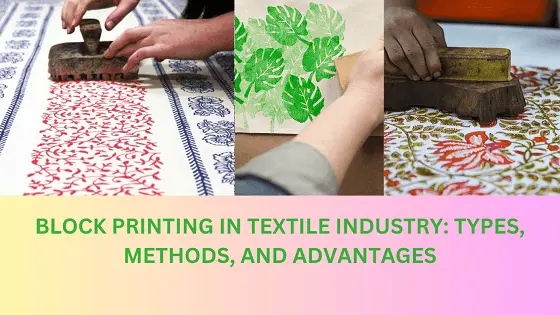Introduction
Textile Printing has over 20 types or methods, block printing is one of them. It is a very old and Manual Method to set print blocks in the fabric. Wooden blocks set to print in the Textile Fabric. Though it is an old process, still carries an important role in Textile printing. Because it makes the fabric very beautiful and well-decorated. The block is made of wood, first introduced in China and India. And then spread out all over the world. In this article we will present what is Block Printing in the Textile Industry: Types, Methods, and Advantages.
What is Block Printing?
Block printing is a printing technique that has engraved wooden block patterns. It is a complete manual printing process that needs human support to do the operation. Block printing is a traditional method of printing on fabric. It sets a design into a block of wood, linoleum, or another material, inking the block, and then pressing it onto the surface to transfer the design. So, it is time-consuming and a slow process but still very popular everywhere.

Types of Block Printing
Block printing on Fabric can be divided into two types in the textile industry printing process. Those are:
- Hand block printing
- Machine block printing
1. Hand block printing
Hand block printing is a traditional method of textile printing where patterns are carved into wooden blocks and then used to stamp designs onto fabric. This process often involves intricate craftsmanship, with each color requiring a separate block. It’s a popular technique in countries like India, where it’s used to create beautiful and unique textiles, including clothing, bed linens, and more.
2. Machine block printing
Machine block printing, also known as rotary screen printing, is a modern and efficient method used in the textile industry for mass-producing printed fabrics. Unlike traditional hand block printing, which relies on manually stamping designs, machine printing employs rotary screens to apply patterns to fabric.
Methods of Block Printing
Block printing methods have evolved over time to meet the demands of contemporary textile production. The basic process involves the following steps:
- Design Creation: The process begins with the creation of a design that will be transferred onto the fabric. Designers may draw directly onto the block or create a digital design that is later transferred to the block.
- Block Carving: Skilled artisans carve the chosen design onto the block material. The precision of this step is crucial, as it determines the quality and intricacy of the final print.
- Color Preparation: Different blocks are used for each color in a design. Artisans mix inks or dyes to achieve the desired color, ensuring consistency throughout the production process.
- Printing: The fabric is stretched onto a flat surface, and the carved block is dipped into the ink or dye. The block is then carefully pressed onto the fabric to transfer the design. This process is repeated to cover the entire fabric.
- Drying and Finishing: After printing, the fabric is allowed to dry. Depending on the design and fabric type, additional processes such as heat setting, washing, or fixing may be required.
Advantages of Block Printing
Block printing offers numerous advantages that contribute to its enduring popularity in the textile industry:
- Artistic Detail: It allows for intricate and artistic detailing, making it an excellent choice for producing unique and visually captivating textiles.
- Customization: Designs can be customized to suit the preferences of designers and customers, making it a versatile method for both small-scale and large-scale production.
- Eco-Friendly: It uses natural dyes and pigments, making it an environmentally friendly choice in contrast to some modern printing methods.
- Handmade Appeal: Consumers appreciate the artisanal and handmade quality of block-printed textiles, which carry a sense of authenticity and cultural richness.
- Heritage and Tradition: This printing has a rich history and cultural significance in various parts of the world, allowing for the preservation of traditional craftsmanship.
- Low Cost and Minimal Space: This printing process is very low-cost, and requires a very small area. Anywhere we can use it whether at home or industry.
Conclusion
In conclusion, block printing remains a timeless and enduring art form within the textile industry. Its varied types and methods cater to a wide range of designs and production needs, and its numerous advantages, including artistic detailing, customization, and eco-friendliness, continue to make it a cherished choice for textile production. Whether for fashion, home decor, or art, block printing’s allure lies in its ability to blend tradition with contemporary creativity, offering consumers a connection to the past while staying relevant in the present.
- You may love to read: Types of Screen Printing, and Its Use
